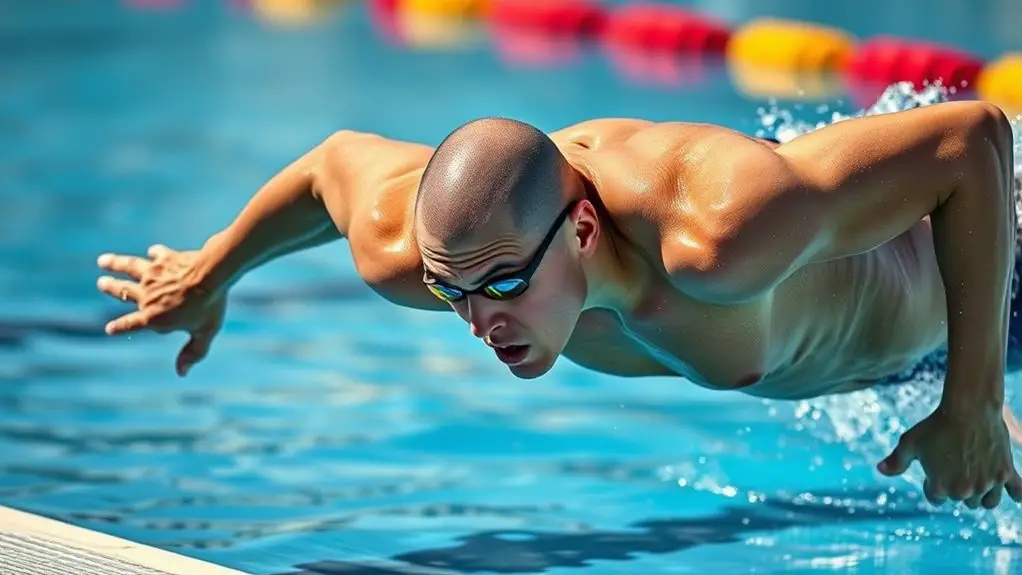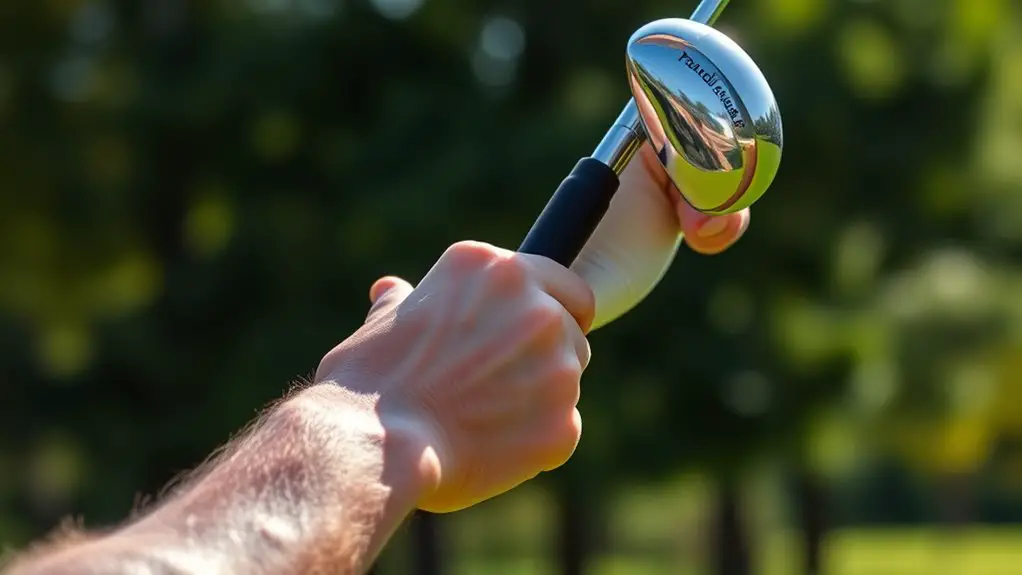High-Intensity Interval Training (HIIT) can greatly enhance your swimming performance. By incorporating short bursts of intense swim intervals followed by recovery periods, you can boost your cardiovascular fitness and muscular strength. Mixing different strokes and drills keeps workouts engaging and effective. Don't forget to combine HIIT with strength training to build power and guarantee proper recovery afterward for ideal results. Want to explore specific HIIT workouts and strategies tailored for swimmers? Keep going to find out more!
Understanding HIIT and Its Benefits for Swimmers
When you think about improving your swimming performance, high-intensity interval training (HIIT) might not be the first method that comes to mind. However, understanding HIIT fundamentals can reveal a whole new level of swimmer endurance. This training method involves short bursts of intense activity followed by rest or low-intensity periods. By incorporating HIIT into your routine, you can boost your cardiovascular fitness and enhance your muscular strength, allowing you to swim faster and longer.
The beauty of HIIT lies in its flexibility—you can mix different strokes or drills, giving you the freedom to tailor your workouts to your preferences. This not only keeps things fresh but also challenges your body in new ways. Plus, the time-efficient nature of HIIT means you can fit it into a busy schedule. Embracing this training style could be a game changer for your swimming journey, helping you reach your goals with vigor. Additionally, incorporating cross-training benefits can further improve your performance and overall fitness.
Essential HIIT Techniques for Enhanced Performance
Incorporating HIIT into your training routine requires specific techniques to maximize its benefits for swimming performance. You can explore various technique variations, like sprint intervals combined with recovery swims, to keep things exciting and effective. Experiment with different distances or stroke techniques during your intervals; this'll not only enhance your overall capability but also prevent monotony.
Focus on performance metrics to track your progress. Use tools like a stopwatch or heart rate monitor to gauge your intensity and recovery times. This data helps you to fine-tune your workouts, ensuring you're pushing your limits without overtraining.
Incorporating rest periods is essential, too—don't underestimate the power of recovery in HIIT. By balancing intense efforts with adequate rest, you'll build endurance and speed efficiently. Additionally, incorporating high-intensity interval training can further enhance your cardiovascular endurance. Embrace these techniques, and watch your swimming performance reach new heights!
Sample HIIT Workouts for Swimmers
Now that you understand the essential HIIT techniques, it's time to explore some sample workouts specifically designed for swimmers. You'll find a mix of dryland HIIT exercises and pool-based interval sets that can really boost your performance. These workouts are tailored to help you improve your speed and endurance in the water. Incorporating sprinting drills can further enhance your acceleration and overall swimming speed.
Dryland HIIT Exercises
Dryland HIIT exercises offer swimmers a powerful way to enhance their performance and build strength outside the pool. You can release your potential with dynamic dryland circuits that combine strength and cardio, keeping your workouts fresh and engaging. Incorporate plyometric drills like box jumps and burpees to improve explosive power and agility, essential for those fast starts and turns. Mix in bodyweight movements like push-ups and lunges, ensuring a well-rounded approach. Aim for short, intense intervals, followed by brief rest periods to maximize your effort and recovery. By embracing these high-intensity workouts, you not only boost your swimming performance but also enjoy the freedom of training anywhere, anytime. Get ready to elevate your game!
Pool-Based Interval Sets
While you might think of swimming as a steady, rhythmic activity, incorporating high-intensity interval training (HIIT) in the pool can dramatically enhance your speed and endurance. Try sets like 8 x 50 meters at a fast pace, resting for 20 seconds between each. Focus on interval timing to maximize your performance. You can also mix in 4 x 100 meters at a sprint pace, with 30 seconds of rest. This helps with pace management and teaches your body to recover quickly. Don't hesitate to adjust intervals according to your fitness level. The beauty of HIIT is its adaptability; you can find what works best for you. Immerse yourself, push your limits, and enjoy the freedom of faster swimming!
Incorporating Strength Training Into Your HIIT Routine
Incorporating strength training into your HIIT routine can greatly enhance your performance in the water. Not only does it build muscle and improve endurance, but it also helps prevent injuries. Let's explore some effective exercises that can complement your swimming training and boost your overall strength. Adding exercises like squats can improve balance and stability, essential for maintaining proper form while swimming.
Benefits of Strength Training
Strength training can greatly enhance your high-intensity interval training (HIIT) routine, as it builds muscle strength and power essential for swimmers. Incorporating strength training into your regimen offers numerous benefits, including:
- Improved muscle development: You'll build lean muscle, which contributes to better performance in the water.
- Increased power output: More strength translates to explosive starts and turns during races.
- Enhanced endurance: Strength training helps you maintain performance throughout longer swims, reducing fatigue.
- Injury prevention: A stronger body can better withstand the demands of swimming and minimize the risk of injuries.
Effective Exercises for Swimmers
To maximize the benefits of high-intensity interval training, swimmers should incorporate effective exercises that target both strength and endurance. Focus on compound movements like squats, lunges, and push-ups to build strength while engaging your core. Incorporating resistance bands can enhance your stroke efficiency, mimicking the resistance felt in water. Don't forget to integrate breathing techniques—practicing rhythmic breathing during strength workouts can carry over to your swim. High-intensity intervals, such as sprinting on land followed by quick recovery periods, help develop explosive power. Combine these elements in your routine for a balanced approach that improves overall performance. Embrace this freedom in exercise, and you'll notice significant gains in your swimming prowess.
Recovery and Nutrition Tips for HIIT Swimmers
When you engage in high-intensity interval training (HIIT) as a swimmer, prioritizing recovery and nutrition is essential for peak performance. Here are some tips to help you recover effectively and fuel your body:
- Hydration strategies: Drink plenty of water before, during, and after your workouts. Electrolyte-rich drinks can also help maintain balance.
- Post workout nutrition: Within 30 minutes of finishing your HIIT session, consume a mix of protein and carbohydrates to aid recovery. Think protein shakes or a banana with peanut butter.
- Rest: Allow your body time to recover. Incorporate rest days into your routine to prevent burnout and injuries.
- Sleep: Aim for 7-9 hours of quality sleep each night. It's vital for muscle recovery and overall performance. Additionally, staying hydrated supports optimal performance during your training sessions, helping you to maintain energy and focus.
Monitoring Progress and Adjusting Your HIIT Plan
Tracking your progress in high-intensity interval training (HIIT) is essential for optimizing performance and ensuring you're on the right path. By keeping a close eye on your workouts, you can identify what's working and what needs tweaking. Use a training journal or app to log your intervals, times, and how you felt during each session. This progress tracking helps you stay motivated and accountable.
As you monitor your results, don't hesitate to make plan adjustments. If you find certain intervals too easy or too hard, modify them to match your evolving abilities. Remember, HIIT should challenge you but also feel exhilarating. Listening to your body and adapting your training accordingly is crucial, especially as adequate recovery plays a vital role in muscle repair and overall performance. By continuously evaluating your progress, you'll not only achieve your swimming goals but also embrace the freedom that comes with personalized training. Stay flexible and enjoy the journey!
Common Mistakes to Avoid When Doing HIIT for Swimming
While high-intensity interval training (HIIT) can be a game-changer for swimmers, certain common mistakes can hinder your progress. Avoiding these pitfalls will help you maximize your workouts and keep your passion alive:
- Neglecting Recovery: Ignoring rest days increases overtraining risks, leaving you fatigued and less effective. Incorporating rest days into your training program is crucial for muscle recovery and overall performance.
- Using Improper Form: Sloppy technique not only hinders performance but can also lead to injuries. Always prioritize form.
- Skipping Warm-Ups: Jumping straight into intense intervals can shock your body. Warm up properly to prepare for the challenge.
- Not Tracking Progress: Failing to monitor your workouts makes it tough to see improvements. Keep a log to celebrate your milestones.
Frequently Asked Questions
Can HIIT Workouts Replace Traditional Swim Training Entirely?
HIIT workouts can't completely replace traditional swim training, but they offer great benefits. You'll boost your swim efficiency and build strength and endurance without spending hours in the pool. Integrating HIIT can enhance your performance, giving you the freedom to mix things up. However, you still need those specific swim drills to perfect your technique. Balancing both will help you reach your goals while keeping your training fresh and exciting.
How Often Should Swimmers Perform HIIT Workouts Each Week?
You'd think that a single HIIT session could turn you into a swimming superstar overnight! However, finding the right HIIT frequency is essential for training balance. Ideally, aim for 2 to 3 HIIT workouts per week, allowing your body to recover and adapt. This way, you can enjoy the freedom of mixing intensity with your regular swim training, maximizing your performance without overloading your muscles. Embrace the journey and let your training evolve!
What Equipment Is Best for HIIT Workouts for Swimmers?
When it comes to HIIT workouts, you'll want equipment that lets you move freely and efficiently. Kettlebell swings are fantastic for building explosive power and strength, while resistance bands offer versatility and can enhance your mobility. You can easily incorporate both into your routine, allowing you to challenge yourself without being tied down to bulky equipment. So, grab those kettlebells and bands, and enjoy the freedom of dynamic workouts that fit your lifestyle!
Are There Specific HIIT Exercises Tailored for Different Swimming Strokes?
You can incorporate stroke specific drills into your HIIT routine for better results. Tailored HIIT exercises for freestyle, backstroke, breaststroke, and butterfly focus on the unique muscle groups used in each stroke. For instance, explosive push-ups and squat jumps can enhance your freestyle power, while resistance band pulls can improve your butterfly technique. Mixing these drills keeps your workouts fresh and lets you enjoy the freedom of swimming with improved efficiency.
Can Beginners Safely Start HIIT Training Without Prior Experience?
Absolutely, you can immerse yourself in HIIT even if you're a total newbie! Just imagine releasing your inner athlete! To guarantee your adventure is safe, stick to safety guidelines and embrace beginner modifications. Start slow, gradually ramp up the intensity, and listen to your body. You're free to explore your limits while respecting them. So, don't hesitate—jump in, have fun, and discover the empowering world of HIIT training at your own pace!




